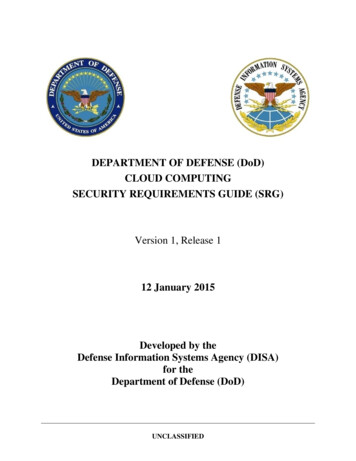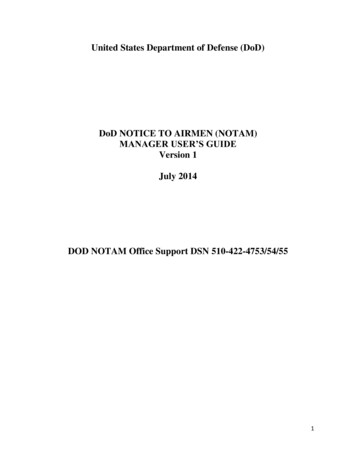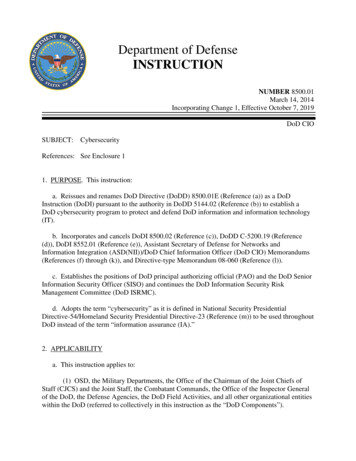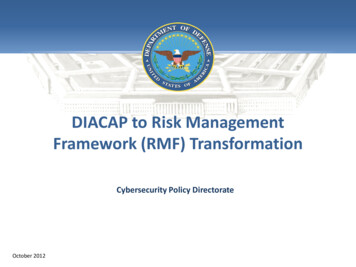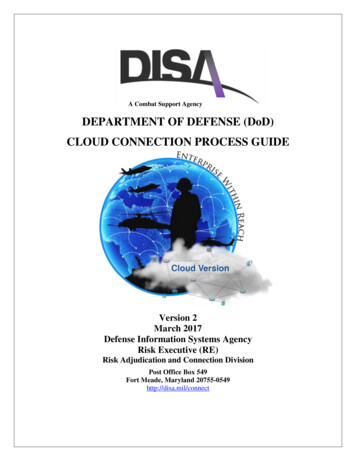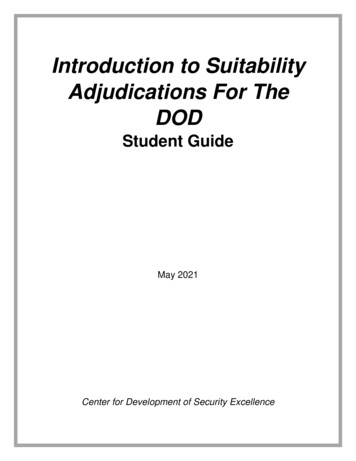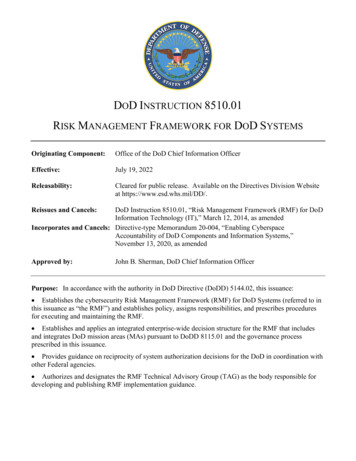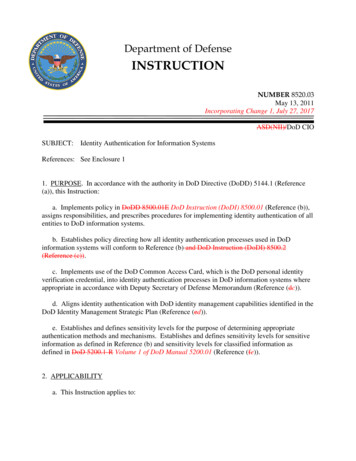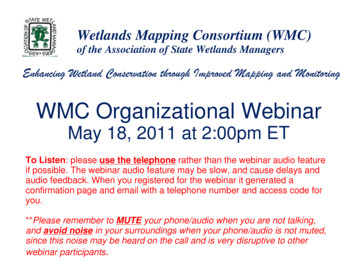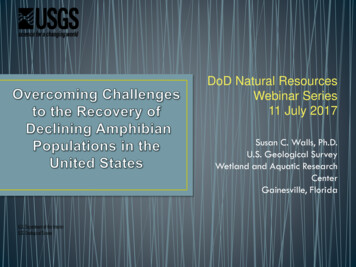
Transcription
DoD Natural ResourcesWebinar Series11 July 2017Susan C. Walls, Ph.D.U.S. Geological SurveyWetland and Aquatic ResearchCenterGainesville, Florida
Endangered Species Act One of the most important environmental laws everenacted in the U.S. Since enacted, 1% of listed species have becomeextinct; status of 52% of listed species has stabilized orimproved
Recovery Success Stories (under the ESA)American Alligator(Alligator mississippiensis)Delisted in 1987Lake Erie Watersnake(Nerodia sipedon insularum)delisted in 2011Kristin StanfordConcho Watersnake(Nerodia paucimaculata)Delisted in 2011Morelet’s Crocodile(Crocodylus moreletii)Delisted in 2012Island Night Lizard(Xantusia riversiana)Delisted in 2014
Yet, no federally-listed amphibian taxonhas yet to be “recovered”
Amphibians are among the most affected taxa inan on-going biodiversity crisis 40%Proportion of species threatened with extinction(extrapolated to include Data Deficient species)Vié et al. 2009
Objectives:1. Explore historical challenges for successfulrecovery of declining amphibians2. Examine the current extent of recovery plandevelopment and critical habitat designationfor listed species of amphibians3. Outline strategic actions that could help reducechallenges
Historical Challenges to RecoveryDelays and biases in: Listing Development and implementation of recovery plans Designation of critical habitatRecovery plans and critical habitat must exist before they caneffectively promote species recovery
Accessed the USFWS EnvironmentalConservation Online System 35 amphibian “taxa” (including Distinct PopulationSegments) currently listed as threatened orendangered Summarized data on(1) year taxa were listed;(2) existence of recovery plans; and(3) existence of designated critical habitat
Percent of Listed Amphibian Taxa302010No Critical HabitatLackBoth0No Recovery Plan5040
EndangeredSouthern mountainyellow-legged frog,ThreatenedYosemite toad,Ozark hellbender, Salado salamander, Sierra Nevada yellow-leggedThreatenedfrog, d
Time Lags after a Species’ ListingYears (mean sd)16141210n 18n 18n 2286n 22420Until completionof recovery planUntil criticalhabitat designation
Delays: median 4.82 yrFrom Walls (2014) (Supplemental Info.)25Longevity (years)Delays in Listing &Longevity of somesoutheastern amphibiansn 19 species201510n 24 species50 2003 Stephen C. RichterAnuransSalamandersLithobates sevosus (Dusky Gopher Frog): 1982: concern about status first raised2001: Listed as endangered2012: Critical habitat designated8-10 generations in the intervening 30 yearsLongevity: 4-5 yr; 6-10 yr. max (Amphibiaweb)Necturus alabamensis (Black Warrior Waterdog): 1991: recognized as a C2 species1999: given candidate status2016: proposed rule to list species as endangeredLongevity: unknown
On a Positive Note .USFWS and NMFS have implemented severalimprovements Development of a multi-year work planRegulation reformSeeking conservation partnershipsAdoption of a Species Status Assessment (SSA) framework(a standardized, analytical approach to using science toinform all ESA decisions; designed to be consistent acrossall taxa) Listing process has become more transparent
Number of species that have receivedfederal protection
Concern for (yet) unlisted“at risk” speciesFrom nt extinction rates are 1,000 timeshigher than natural background rates ofextinction and future rates are likely to be10,000 times higher (Vos et al. 2015).
Proactive (or prelisting) conservation Targets at-risk species before they need the protection of the ESA “An idea whose time has come” (Waples 2016) Not intended to supplant ESA protection but, rather, should be viewedas a means of increasing its effectiveness Has led to successful recovery of many at-risk species, thus eliminatingtheir need for listing under the ESARecent Examples:Least ChubGreater Sage Grouse(removed from Candidate List in 2014)(removed in 2015)Relict Leopard Frog(removed in 2016)
Advantages of Proactive ConservationStrategies1. can prevent the need for listing2. conservation efforts getunderway sooner3. reduces risk of extinction bynot allowing populations todecline to very low levels4. saves money
Advantage 1:Proactive conservation can prevent the need for listing Again accessed the U.S. Fish and Wildlife Service (USFWS)Environmental Conservation Online System (ECOS) Summarized number of plant, invertebrate, fish, amphibian,reptile, bird, and mammal taxa that have had “successful”conservation outcomes “Taxon” defined as before An effort was considered “successful” if it led to:(1) delisting a species due to recovery (as defined by theUSFWS) or(2) not listing a species because doing so was precluded byproactive conservation efforts.
Data from: USFWS Environmental Conservation Online Systemhttp://ecos.fws.gov
Advantage 2: Expeditious conservation preventspopulations from declining to very low levelsBlack-Footed Ferret(Mustela nigripes)Red Wolf(Canis lupus)California Condor(Gymnogyps californianus) All three species listed as endangered in 1967 and continued to decline When taken into captivity, only 18 ferrets, 17 red wolves, and 27 condorsremained in the wild All three recovery programs have experienced a number of successfulmilestones and failures but, currently, all three remain endangered underthe ESA
Advantage 3: saves money Globally, annual cost to reduce extinction risk of threatened specieshas been estimated at US 76 billion (Baruch-Mordo et al. 2013) In the US, annual cost to protect endangered species from just 2conservation threats (alien species and disruption of natural fire disturbanceregimes) was estimated at US 32-42 million (in 1997 US) Because of cost, in many cases conservation only starts whenspecies are under mandated statutory protection to prevent extinction In a case study from 2011, a proactive approach would have saved between17.2 mn and 36.4 mn euro ( 18.6 mn to 39.2 mn) compared to existing policywhere conservation was delayed (Drechsler et al. 2011)
Suitable species for proactive conservationSpecies proposed for federal listing: Louisiana pine snake (Pituophis rutheveni): Proposed as ThreatenedSonoyta mud turtle (Kinosternon sonoriense longifemorale): Proposed as EndangeredBlack warrior waterdog (Necturus alabamensis): Proposed as EndangeredFederal Candidate Species: Striped newt (Notophthalmus perstriatus) Berry cave salamander (Gyrinophilus gulolineatus) Gopher tortoise (Gopherus polyphemus)(Notophthalmus perstriatus)(Striped Newt)CandidatePituophis rutheveni(Louisiana pine snake)Proposed ThreatenedGopherus polyphemus(Gopher Tortoise); Candidate
Out of 60 studies reviewed, only 22% indicated that aproactive conservation strategy had actually beenimplementedNumber of studies in various regions of the world in which proactiveconservation was implemented or the need for such a strategy wasrecognized
Conclusions Historically, federally-listed amphibians have experienceddelays in listing, development of recovery plans, anddesignation of critical habitat. In terms of listing delays, amphibians have fared betterthan most other species (4.82 years vs. 12.1 yearscalculated in another study) Amphibians doing better in terms of designation ofcritical habitat (71.4% of listed amphibians have criticalhabitat vs. 45% of all listed species) Amphibians and reptiles are under-represented amongthose species that have been recovered, even thoughthey are 2 of the most imperiled of all the vertebrate groups.
Conclusions, cont’d. Proactive conservation can lead - and has led - to recoveryof many at-risk species, thus eliminating their need forlisting under the ESA Several options for engaging in proactive conservation.For example:- The USGS ARMI program and others are developing aproactive management framework to plan responses to(Bsal).- Start (or continue) restoring habitat; PARC’s HabitatManagement Guidelines are excellent resources
- Make use of novel conservation toolse.g. water-borne stress hormone (Corticosterone or CORT) assaysChronic physiological stressdrivesChange in extinction/colonization ratesmechanismsofChange in occurrence aacross a landscapeexplainsSpecies distributionpatternsProvides “earlywarning system”that can signalat-risk populations
Conclusions, cont’d.- Start a long-term monitoring program that is:- question-driven- amenable to statistical/modeling rigor (e.g. occupancy and/orabundance estimation)- Collect much-needed demographic/genetic data- Identify triggers that, if/when reached, will signal the need forconservation intervention. Decide these ahead of time, not post hoc.- Try to anticipate the types of information that could be needed,should species you manage become in need of listing:- what is the potential for dispersal, metapopulation connectivity?- where is there habitat on the landscape that is suitable (or couldbe made suitable) for translocations?- Engage your partners
“Partnerships not only combineexpertise. They can also pool theirresources to fund the scientificefforts that guide managementactions.”D. Kobilinsky. 2017. The WildlifeProfessional 11(4):16-22.
AcknowledgmentsCo-authors: Lianne Ball, Jamie Barichivich, Ken Dodd, Kevin Enge, Tom Gorman,Katie O’Donnell, John Palis, Ray SemlitschFor sharing photos: Sam Murray: Yosemite toad and Sierra Nevada yellow-legged frogTodd Hoggan: southern mountain yellow-legged frogNathan Bendik: Salado salamander and Georgetown salamanderKory Roberts: Ozark hellbenderFunding:USGS Amphibian Research and Monitoring Initiative (ARMI)Edits/Support:Joe Mitchell
California Condor (Gymnogyps californianus) Red Wolf Canis lupus) All three species listed as endangered in 1967 and continued to decline When taken into captivity, only 18 ferrets, 17 red wolves, and 27 condors remained in the wild All three recovery programs have experienced a number of successful
